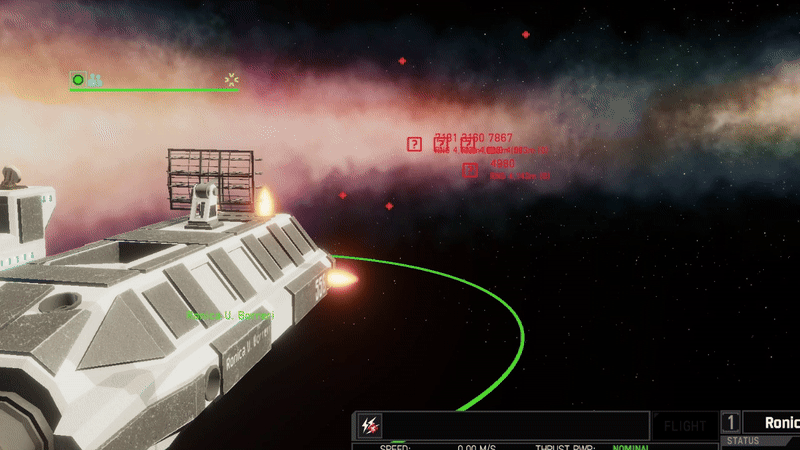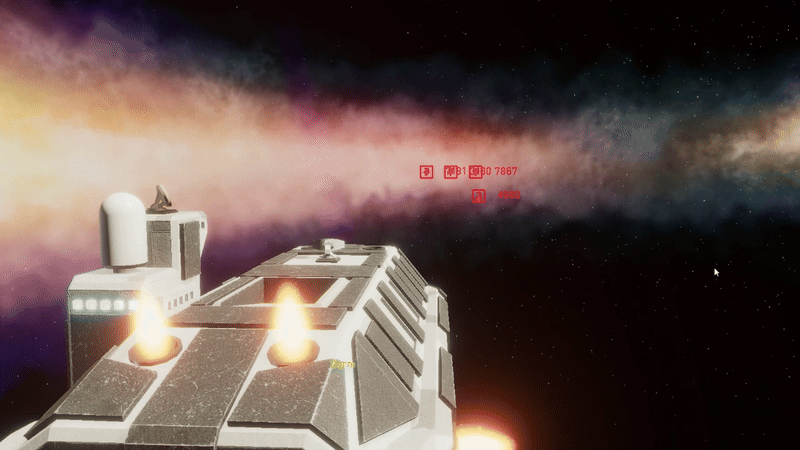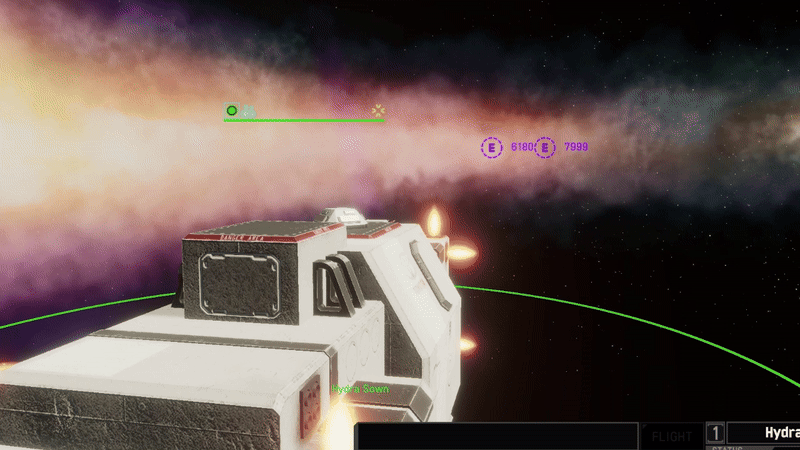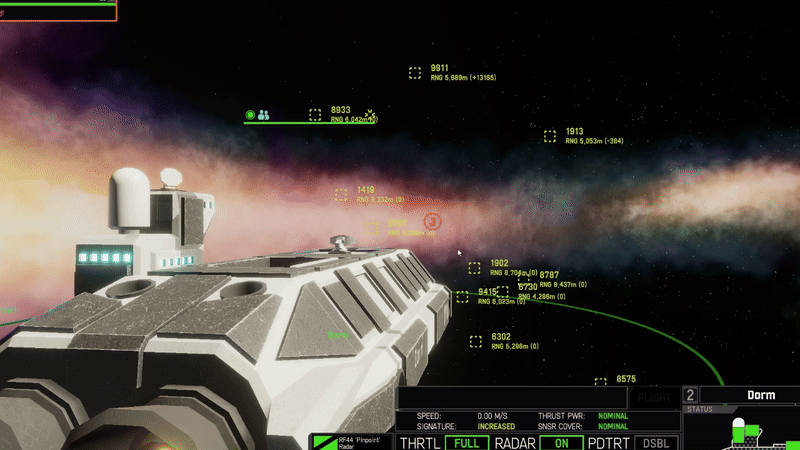use electronic warfare to bring together radar and weaponry
weapons and radar should have a close association in combat in SE2. radar should not only provide some search benefits, but should serve as the basis for how AI blocks and guns see enemies. radar shouldn't be an optional sensor to help you find other players, it should be a necessary component to operate any armament on your ship that isn't manually aimed.
another game, NEBULOUS: Fleet Command (N:FC), does this exceptionally well, so i will use gifs from there to demonstrate how a similar system could work in SE2.
the radar system could easily be broken down into 3 values: tracking distance, tracking quality, and tracking type
1: Tracking Distance
tracking distance would determine how far out you spot a target.
an engineer making unarmed civilian vessels could use large surveillance radars that would let him know of any incoming hostile ships at a great distance. these radars would draw a lot of power and provide little benefit to a ship in combat as the quality of the track would be terrible.

GIF of long distance low quality search radar in N:FC. each scattered red diamond represents where an AI-controlled weapon would point if the crew attempted to fire on that track. for the sake of view-ability, the full range of this radar is not demonstrated.
warships would instead opt to use higher frequency radars with lower range but higher tracking quality.
2: Tracking Quality
tracking quality would determine how effective of a firing solution your AI turrets will have when shooting at someone tracked by your radar.
low track quality = signal marker bounces around where the enemy ship actually is
high track quality = signal marker holds steady around the enemy ship's true location
an engineer building a warship will opt for higher frequency radars that give him a clear track that wont cause all of his cannon shots to miss, the downside would be he now has less range to search for new targets.

GIF of short distance high quality search radar in N:FC. take note of how the red tracking diamonds are no longer scattered but are instead almost directly overlain upon the signature source.
since he wont have enough power leftover to run both a high and a low frequency radar, the engineer would have to try to track his targets at a longer range by using their own radar against them.
3: Tracking Types
the incoming radar waves of an enemy ship's radar could be used against them to triangulate their position and get an extremely rough idea of where they might be.
a smart warring engineer would mount ESM modules on a couple of his ships to detect when anxious cargo haulers are constantly running their radar.
this type of tracking would provide horrible quality, but it would give a rough idea of where the enemy is

GIF of an ESM module in N:FC. Take note of how only the Tracking ID is displayed, there is no distance or red tracking diamond present. Weapons cannot fire on this target until it is detected with an actual radar.
meanwhile a smart trader or miner would only use his radar briefly every few minutes and shut it off and flee once he locates an enemy and realizes it is approaching him.
the same defensive player could mount his own ESM device to detect when someone has pointed a radar at him.
there could be additional forms of tracking such as thermal and radio
thermal could be a cheaper alternative that allows players to track engine signatures, but will only be able to detect ships while they are accelerating or decelerating. this is a feature already present in many SE1 community servers.
radio would basically be what is currently in SE1, you just follow an enemy's antenna or beacon signal. i feel that in SE2 there should be private antenna channels which show allies exactly where you are but only give enemies a very rough idea of your location.
Other Notes
jammers could potentially saturate someones radar temporarily, putting fake warship signals all over their screen whilst the jammer is active and pointed in their direction.

GIF of my ship being jammed in N:FC. Take note of how the ship jamming me has no data shown, not even its tracking ID. The only detail present is a "J" in the direction of the jamming source. The yellow false markers are only present in the direction I am being jammed from.
custom missiles could benefit from having seeker blocks that follow incoming radar signals or even emit their own radar signals. radar could be the basis for how AI blocks are able to see enemies
smaller and more flat ships could potentially receive some bonuses to stealth by having radar be less likely to pick up their signature.
radar signatures dont have to be super in-depth, the system could just be based on the amount of PCU on your grid. more PCU = more signature. this would help casual players feel less overwhelmed by such a mechanic



 I like this feedback
I like this feedback
Pretty interesting suggestion here. Seems pretty simple without going overboard nor relying too much on realism; though, I would prefer if there was some way to approach without being hit by radar (thruster/thermal based, as you said, or perhaps just radio).
I know in some other Sci-fi scenarios with ships they have thruster cones and that kind of thing, so maybe something with that? Dunno. Could even be something like "If X grid is too slow" or "too close to asteroid" then it can't be detected? Would love to see if they add this, or perhaps as a mod.
Pretty interesting suggestion here. Seems pretty simple without going overboard nor relying too much on realism; though, I would prefer if there was some way to approach without being hit by radar (thruster/thermal based, as you said, or perhaps just radio).
I know in some other Sci-fi scenarios with ships they have thruster cones and that kind of thing, so maybe something with that? Dunno. Could even be something like "If X grid is too slow" or "too close to asteroid" then it can't be detected? Would love to see if they add this, or perhaps as a mod.
The idea of radars and target acquisition/tracking is an interesting one, though given the nature of the game the idea of having only one radar for lack of power is a rather odd one. When not playing a server that limits reactors I find it isn't hard to easily get several hundred MW of power once one has access to uranium. Subsequently I might instead advise taking a page or two out of IRL radars to try and balance them with things like targeting radar covering only a limited arc and larger radars having increased detection/lock range. It will probably also be necessary to limit how quickly a radar can be turned off and on, lest a scripter do something silly where they only have their radar on one tick out of every twenty to make them hard to detect while the script compensates for the missing time to still accurately target weapons.
...It might also be interesting to include requiring ship's computer-power to determine how many targets can be tracked, and the ability for ships to share target-data via antenna (or whatever SE2's equivalent is).
The idea of radars and target acquisition/tracking is an interesting one, though given the nature of the game the idea of having only one radar for lack of power is a rather odd one. When not playing a server that limits reactors I find it isn't hard to easily get several hundred MW of power once one has access to uranium. Subsequently I might instead advise taking a page or two out of IRL radars to try and balance them with things like targeting radar covering only a limited arc and larger radars having increased detection/lock range. It will probably also be necessary to limit how quickly a radar can be turned off and on, lest a scripter do something silly where they only have their radar on one tick out of every twenty to make them hard to detect while the script compensates for the missing time to still accurately target weapons.
...It might also be interesting to include requiring ship's computer-power to determine how many targets can be tracked, and the ability for ships to share target-data via antenna (or whatever SE2's equivalent is).
All considerations regarding the radar system encounter one fundamental problem:
We have a game engine that has all the necessary information.
The problem lies in how to give the player an appropriate amount of this information in order to maintain the balance of the game.
So considerations about the radar system should start from this point.
If we wanted to correctly simulate a real radar:
The scanned space is divided into conical or pyramidal segments with vertices in the radar antenna. The "radar system" scans all segments step by step, one by one. At each step, the "radar system" asks the "game engine" three questions:
- Does the segment currently being scanned contain any game objects?
- At what distance?
- Is the game object in the scanned segment a voxel object or a grid?
This is followed by scanning the next segment and asking the same questions.
The performance of a simulated computer radar system is determined by the number of segments (basically their angular width) and the speed at which they are scanned.
In real radar, the scanned segment may not be regular; for example, marine radars for searching for surface targets often have a "plate" shape that is wide in the vertical direction. The third coordinate is defined by the sea surface.
The transmission power of the simulated radar determines the length of the segment (note that the range of a real radar is a function of the fourth power of the power, so to double the range we need sixteen times the power – or sixteen times the antenna area).
Such simulations work better in a polar coordinate system than in the rectangular coordinate system used in the game....
All considerations regarding the radar system encounter one fundamental problem:
We have a game engine that has all the necessary information.
The problem lies in how to give the player an appropriate amount of this information in order to maintain the balance of the game.
So considerations about the radar system should start from this point.
If we wanted to correctly simulate a real radar:
The scanned space is divided into conical or pyramidal segments with vertices in the radar antenna. The "radar system" scans all segments step by step, one by one. At each step, the "radar system" asks the "game engine" three questions:
- Does the segment currently being scanned contain any game objects?
- At what distance?
- Is the game object in the scanned segment a voxel object or a grid?
This is followed by scanning the next segment and asking the same questions.
The performance of a simulated computer radar system is determined by the number of segments (basically their angular width) and the speed at which they are scanned.
In real radar, the scanned segment may not be regular; for example, marine radars for searching for surface targets often have a "plate" shape that is wide in the vertical direction. The third coordinate is defined by the sea surface.
The transmission power of the simulated radar determines the length of the segment (note that the range of a real radar is a function of the fourth power of the power, so to double the range we need sixteen times the power – or sixteen times the antenna area).
Such simulations work better in a polar coordinate system than in the rectangular coordinate system used in the game....
I find the concept of RADAR to be much less interesting when it isn't complex. In the sense of, I don't want a single block to be plonked down onto every ship, and immediately every other ship in range is visible because you happen to be within range. I'd like to be able to hide, passive/active RADAR (or SONAR for water...), and I'd prefer it wasn't so simple as just outlining a square on the exact center of the ship in 3D. I'd like to put those various screens in our command centers to use, so that we can track things, rather than simply immediately know what's around. It adds skill and forethought for scouting and pre-combat instances that can let smaller vessels get an upper hand on larger ones, if they play their cards right. Versus a giant catch-all "you have a RADAR block on this grid, so in the pilot's seat you get a square on every other grid" approach.
I find the concept of RADAR to be much less interesting when it isn't complex. In the sense of, I don't want a single block to be plonked down onto every ship, and immediately every other ship in range is visible because you happen to be within range. I'd like to be able to hide, passive/active RADAR (or SONAR for water...), and I'd prefer it wasn't so simple as just outlining a square on the exact center of the ship in 3D. I'd like to put those various screens in our command centers to use, so that we can track things, rather than simply immediately know what's around. It adds skill and forethought for scouting and pre-combat instances that can let smaller vessels get an upper hand on larger ones, if they play their cards right. Versus a giant catch-all "you have a RADAR block on this grid, so in the pilot's seat you get a square on every other grid" approach.
Replies have been locked on this page!